ALL-AMERICAN THANKSGIVING
/1 Comment/in Fruit, Gardening, Vegetables/by Lee ReichDanger of Squashing
Thanksgiving is a most appropriate time to put together a truly American meal, one made up of native plants, many of which are easily grown, that might have shown up on the original Thanksgiving table about 400 years ago.
(The date of that first feast was 1623 but the date for celebrating Thanksgiving in all states— on the final Thursday in November — was not fixed until 1863, with a presidential proclamation. Lincoln hoped that a unified date throughout the country would help unify the nation during the divisive days of the Civil War. Not so. Confederate States refused to accept that date until the next decade, during Reconstruction. Another presidential proclamation, by F.D.R. changed the date to the 4th Thursday of November, in an attempt to boost the economy. Would a new date help now?)
On to garden history . . . Back in early November, I picked a 20 pound berry that was growing from my compost pile. Actually, I harvested about a dozen of these heavy berries. Don’t imagine them in terms of strawberries or blueberries. Imagine a winter squash, which botanically-speaking is a berry, a special kind of berry called a pepo. Squashes are native American fruits.
Twenty pounds is no lightweight for a squash. Nothing like the 2,023 pound (still a berry) record-holding pumpkin, of course, but big nonetheless. Especially so when you consider that mine weren’t grown to vie for any records, but for eating.
Argonaut is the variety name of my 20 pound berries. It seems to be a kind of butternut squash stretched out anywhere from 20 to 30 inches long and 8 inches across at its fattest point. It’s relatively easy to grow if you can figure out where to let the 20-foot-long vines trail. In May I had sown the seeds in 4-inch pots and then transplanted a few right atop my compost bin. I put another couple into compost-filled holes I had scooped out in a mountain of leaves (for future use, after rotting down into rich “leaf mold”) kindly deposited here by a local landscaper.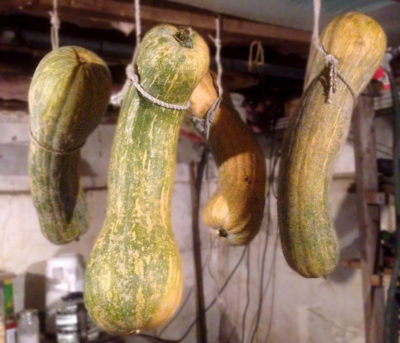
Argonaut needs a long season before the fruits turn buff tan ripe. Longer than my plants got, this year, at least, because only some of them had only some ripe color. Still, they taste very good, and squashes will ripen, to some degree, after harvest.
The question is what to do with a dozen humongous squashes. Ideal storage is in a cool room: my basement, where temperatures no and in the next few weeks will be in the low 50s. Mice occasionally make their way into my basement. They could make many meals of the squashes. I mouse-proofed each one by tying it with a sturdy length of rope in a noose around its neck, then hanging it from the basement rafters.
More Than a Snack Food
Corn is another native American food, with popcorn predating that first Thanksgiving in America by thousands of years. Kernels have been found in the remains of Central American settlements almost 7000 years old. Four hundred years ago, the Pawtuxet Indian Chief, Massasoit, showed up at the first Thanksgiving feast with a deerskin sack filled with popcorn, a food hitherto unknown to the colonists.
Popcorn is the corn I’ll bring to our Thanksgiving table. Most people eat popcorn as a snack, but there’s no reason it couldn’t stand-in for potatoes, rice, bread, or any other carbohydrate-rich foods. Popcorn has the advantage of always being whole grain, and being very quick and easy to prepare.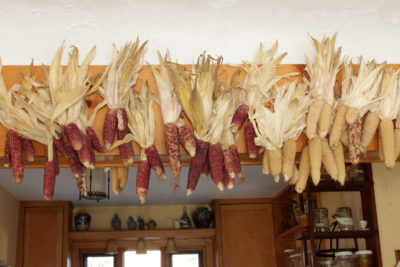
Corn was the best grain crop to grow in the rude conditions of a settler’s clearing. Little land preparation was needed, and the ripe ears could be left dangling on the stalks until there was time for harvest. I could grow it under “ruder” conditions, but I plant it in compost-enriched soil with drip irrigation for consistent water. Two 12-foot long by 3-foot wide beds provide enough popcorn to carry us through the year to the next harvest season.
Since harvest, a few weeks ago, unshelled ears of Pink Pearl and Dutch Butter popcorn have been hanging from the kitchen rafters, decoratively and conveniently at hand.
Bogless Cranberries
Cranberries are among the few native American fruits sold commercially. Although they do not provide a great deal of nourishment, they spice up present and past holiday dinners.
Cranberries can be grown in a home garden if the soil is very acidic (sulfur will make it so if it is not), rich in organic matter, and has consistent moisture. A bog is not needed.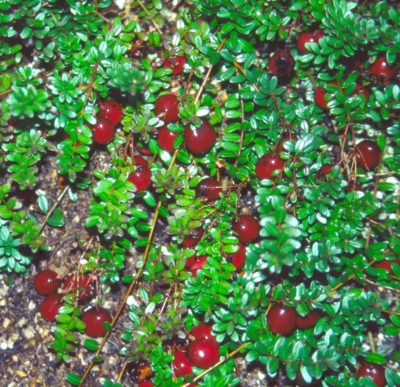
Given the right growing conditions, cranberries can be an ornamental, edible groundcover. I once planted them as such, along with the other edible, ornamentals lowbush blueberry and lingonberry, as well as rhododendron and mountain laurel, non-edibles that enjoy these same soil conditions. The cranberries grew too well, threatening to overtake the rest of the bed. Since they were not my favorites among all the plants in the bed, they no longer live there.
Many more native American plants, such as beans, groundnuts, and Jerusalem artichokes, can round out this Thanksgiving feast. And, of course, among non-plants, turkey.
SENSORY DELIGHTS, NOW AND FUTURE
/9 Comments/in Flowers, Fruit, Gardening, Houseplants, Planning/by Lee ReichA Scented Wave
For the past couple of weeks, every time I walk upstairs to my home office, a sweet aroma hits me like a wave a few steps before I reach the top stair. This wave pulls me forward, a room and a half away, to the Meyer lemon plant sitting in my office’s sunny, south-facing window.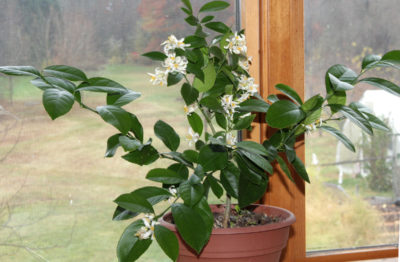
The wave began when only a single Meyer lemon flower had opened. Now, the plant, only a foot and a half high, is decked out with more than 20 flowers.
This “tree” started life as a cutting I took from a friend’s old tree that anyway needed some pruning. With their bottom leaves stripped off, the 6 inch long stems rooted reliably in a few weeks after their bottom portions were plunged into a moist mix of equal parts peat and perlite, and transpiration was reduced with a clear plastic overhead. Bright, but indirect, light allowed for photosynthesis without cooking the plants in their “mini-greenhouse.”
My most important job now is to keep an eye out for scale insects, which show up as either brown bumps (armored scale) or cottony tufts (cottony cushion scale) on leaves and stems. Rubbing off these insects or dabbing them with a Q-tip soaked in alcohol deals with them unless the population gets out of hand. Repeated sprays with horticultural oil can be the next line of defense.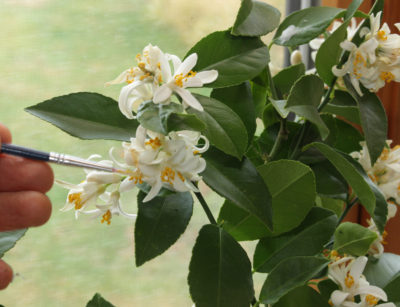
Every couple of days I pick up the artist’s brush lying next to the potted plant, and dab it on the tips of some of the flowers. I’m not painting; I’m picking up the yellow pollen from each flower’s male anthers and dusting it onto each flower’s, and neighboring flower’s, female stigmas.
A good proportion of those pollinated flowers should go on to provide the next treat from Meyer lemon, fruit, which this plant usually bears prolifically. Meyer lemon is actually a hybrid of lemon and sweet orange, with both parents reflected in the flavor. A final plus for this plant is, in contrast to many other citrus plants, is that its stems lack thorns.
Another Fig Option
Greenhouse figs still bear fruit; with low light and cool temperatures, they’re not worth eating. I did recently harvest a few figs from a Kadota fig plant that had been planted outdoors.
“Had been planted outdoors?” So where is it now? It’s still outdoors, but not planted. It’s in a pot. Like my few other potted figs, the potted Kadota plant will move down to the basement before temperatures drop below 20°F.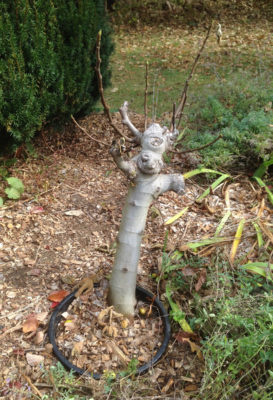
Unlike my other potted figs, the Kadota plant did not require daily watering all summer. Or yearly root pruning and repotting to give the roots new room to grow and explore. The reason is because Kadota is in an 18” diameter plastic pot with some holes I drilled in its side. In spring, I sunk the pot up to its rim into a waiting hole in a bed on the sunny, south side of my house. The plant’s roots wandered outside the pot into the surrounding soil through the existing opening in the bottom of the pot, as well as through the side openings. Once outside the pot, roots were able to fend for themselves garnering water and nutrients for the small tree.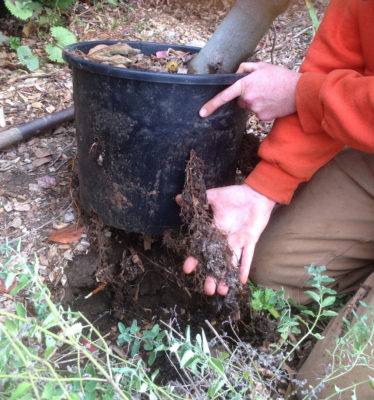
Kadota, like many other fig varieties (but few other kinds of fruits), bears fruit on new shoots. Very convenient. Rather than having to squeeze spreading limbs down my narrow basement stairs, I can cut back all the stems rather drastically, which also has the benefit of stimulating vigorous, new shoots at the cut stub, new shoots that will bear fruit next year. Not too drastically, though, or too long a time might be required for the fruit to develop and ripen. And Kadota is already a late ripening variety.
Of all my figs, Kadota is my favorite, both for its almost chewy skin and the rich, sweet flavor lying within. Even those recently harvested ones.
Comely, Fragrant, and Poisonous
Another sensory treat slated for winter comes compliments of Angels’ Trumpets (Brugmansia spp.). The flowers of these poisonous(!), subtropical trees are giant, 6 inch long trumpets in pale colors and from which wafts a delicious aroma, especially at night. These subtropical plants can grow into trees but are easily kept much small, in pots, in cold climates.
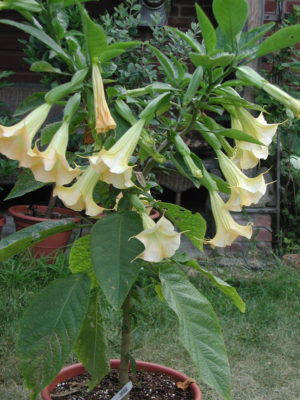
Angels Trumpets, in past years
I neglected my plant all summer and on into fall; when I retrieved it to protect it from coldest nights, it was just about leafless and ready for the compost pile. Then I noticed some small leaves beginning to develop along its almost bare stems. And some stems had the beginnings of flowers on them.
So I brought Angels’ Trumpet indoors, next to a sunny window (and next to the Meyer lemon). It looks sad now but should revive and, judging from my previous experiences with this plant, flower well most of winter. In summer, with long days, it takes a rest from flowering — which is why I ignored the plant.
UBER ORGANIC & A BEAUTIFUL BLOSSOM
/0 Comments/in Flowers, Gardening, Planning, Soil, Vegetables/by Lee Reich‘Tis the Season
’Tis the season to really put the “organic” in organic gardening. “Organic,” as in organic materials, natural compounds composed mostly of carbon, hydrogen, and oxygen. “Organic,” as in materials that are or were once living, things like compost, leaves, manure, and hay.
I’ve spread compost over almost all my vegetable garden beds. A one inch depth laid atop each bed provides all the nutrients the vegetable plants need for a whole season, in addition to other benefits such as snuffing out weeds, holding moisture, improving aeration, and nurturing beneficial, pest-fighting organisms.
I’m also finishing up the bulk of making new compost for the year. Pretty much everything organic — old vegetable plants, kitchen trimmings, even old cotton clothing — go into the compost piles. The primary foods, though, are hay, which I scythe, rake up, and then haul over from my hayfield, and horse manure, which I pitchfork into the bed of my truck, then unload into a garden cart to haul over to the compost bins.
Autumn leaves piled up last year have rotted down into “leaf mold,” essentially the same material as compost, with the same benefits. This pile arrived as a truckload last autumn thanks to the generosity of a local landscaper. The leaf mold isn’t quite as thoroughly broken down as the compost so I’m hauling that over to all my young trees and shrubs, and then spreading it beneath them.
I’m also on the lookout for trash bags stuffed with leaves. Local leaf gatherers/baggers contact me when bags are ready for pickup. I toss the bulging bags into the bed of my pickup truck, then haul them over to and unbag them beneath my blueberry, raspberry, currant, and gooseberry bushes.
Organic Matters
All this compost, hay, manure, leaf mold, and leaves are food for soil organisms. Most of the food is carbohydrates, the carbon, hydrogen, and oxygen that combine to make sugars, starches, cellulose, chitin, and pectin of living organisms. As carbohydrates are gobbled up, nutrients are released for plants.
In their raw state, these organic materials are relatively low in plant nutrients. Compare the one pound of phosphate you get from ten pounds of 10-10-10 chemical fertilizer with the 100 pounds of compost you need to offer that same amount of phosphorus.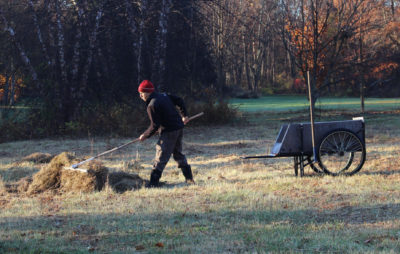
You could get that one pound of phosphate from only ten pounds of an “organic” source such as bone meal. That would be easier than shoveling out 100 pounds of compost — but the soil would then be deprived of 90 pounds of carbohydrate and other bulk that feeds soil organisms and, in turn, bestows physical, nutritional, and biological benefits in the soil.
So I’m continuing to haul manure, hay, leaves, leaf mold, and compost for my garden. It’s also good exercise.
A Beaut’ Worth Reviving for Winter
Much lighter work is digging up an amaryllis bulb. I’ve always considered amaryllis too gaudy a plant, one giant, often flaming red flower appearing atop a bare stalk in early winter. And then, last autumn, someone sent me a big, fat amaryllis bulb along with a pot to plant it in, as well as some potting mix. How could I help but plant it?
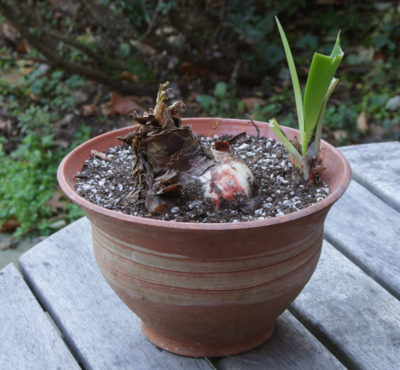
Amaryllis now
The flowers were prolific and awesome, flower after flower (yes, flaming red) appearing on each stalk, and stalk after stalk of flowers. This one was a keeper.
Green leaves, the more the better, are what fuel the following year’s blossoms. (One flower stalk for every nine leaves, according to one source.) Periodic little fertilizer and, as needed, water kept the plant growing well until warm weather settled in for good in spring. Then I tipped the bulb out of its pot and nestled into a hole in a bed in part shade with rich soil and drip irrigation.
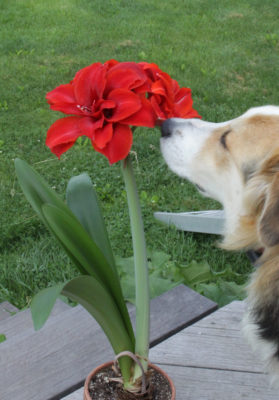
Amaryllis late last winter
Just before a night when temperatures dipped into the low 20s, I dug up the bulb and potted it up. It now sits, unwatered and leafless, in the cool temperatures of my north-facing mudroom. A couple of months of cool temperatures, 50 to 60°F, is good for waking up the flower buds within the now fatter bulb — and its small, baby pup, thank you.

